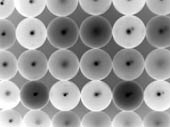
Purpose
To demonstrate how to create a translucent (naked) egg by causing a chemical reaction to break-down its calcium and erode it’s shell.
Additional information
The incredible edible egg! After this experiment you may want to think twice before actually eating it. By the time you're done you'll have a translucent egg where you can actually see the egg yolk sloshing around as you shake it. We'll do this by causing a chemical reaction to break down the calcium of the egg shell, eroding it down to the egg membrane.
Calcium is the chemical element with the atomic number 20 and the CA symbol. It’s the 5th most abundant element by mass in the earths crust.
Sponsored Links
Required materials
- One or more eggs (raw, not hard-boiled)
- Large glass jar or tall drinking glass
- White vinegar
- Pen or pencil
- Journal (to record your results)
Estimated Experiment Time
About 5 minutes to set-up, another 72 hours for results.
Step-By-Step Procedure
- 1. Place your raw egg in your jar or drinking glass.
- 2. Pour vinegar into the jar or glass until the egg is completely submerged in the vinegar.
- 3. Place the jar or glass in a location where it will remain for 24 hours undisturbed.
- 4. After 24 hours, observe the egg. What do you see? Note the results in your journal (you should see tiny bubbles starting to form on the egg shell).
- 5. Drain the old vinegar from the glass into a sink. You want to be very careful not to drop your egg! It's recommended you use a strainer to keep your egg from falling down the drain. Once drained, fill the jar or glass with fresh vinegar so that the egg is once again completely submerged.
- 6. Once again place the jar or glass in a safe place where the egg can remain undisturbed for an additional 48 hours (2 days this time).
- 7. After another 48 hours has passed, observe the egg and write down noticeable changes in your journal.
- 8. Very carefully pour the old vinegar from the jar or glass and into a sink.
- 9. Carefully remove the egg and rinse it under low-running cold water. What do you see? The egg shell should be completely dissolved, creating a translucent egg! All that remains is the egg membrane. Note the results in your journal.
Note
DO NOT EAT THIS EGG! Never eat raw eggs as they can result in serious illness.
Observation
What do you think would happen if you let the egg soak in the vinegar for longer? How about if you left it in there for 1 week? How about a month? Give it a try and see for yourself! You can also try other liquids to see how the egg reacts to being submerged in them.
Result
The egg shell is made from calcium carbonate. When the egg is subjected to prolonged exposure of the vinegar (an acetic acid), the vinegar reacts with the calcium carbonate of the shell by breaking it into calcium and carbon dioxide gas, eroding the shell.
Sponsored Links
Take a moment to visit our table of Periodic Elements page where you can get an in-depth view of all the elements,
complete with the industry first side-by-side element comparisons!